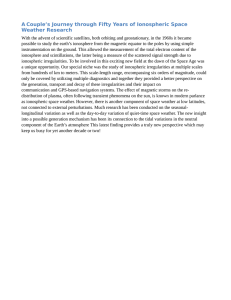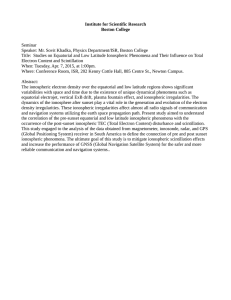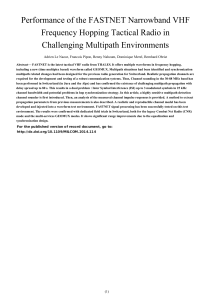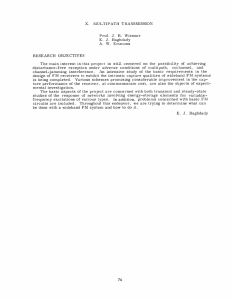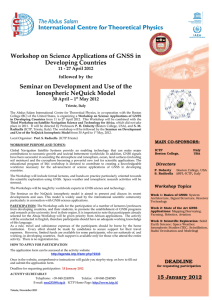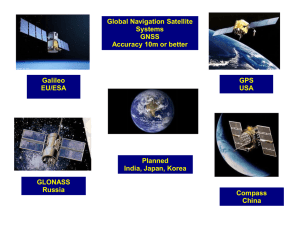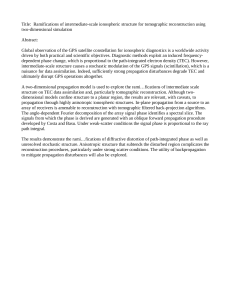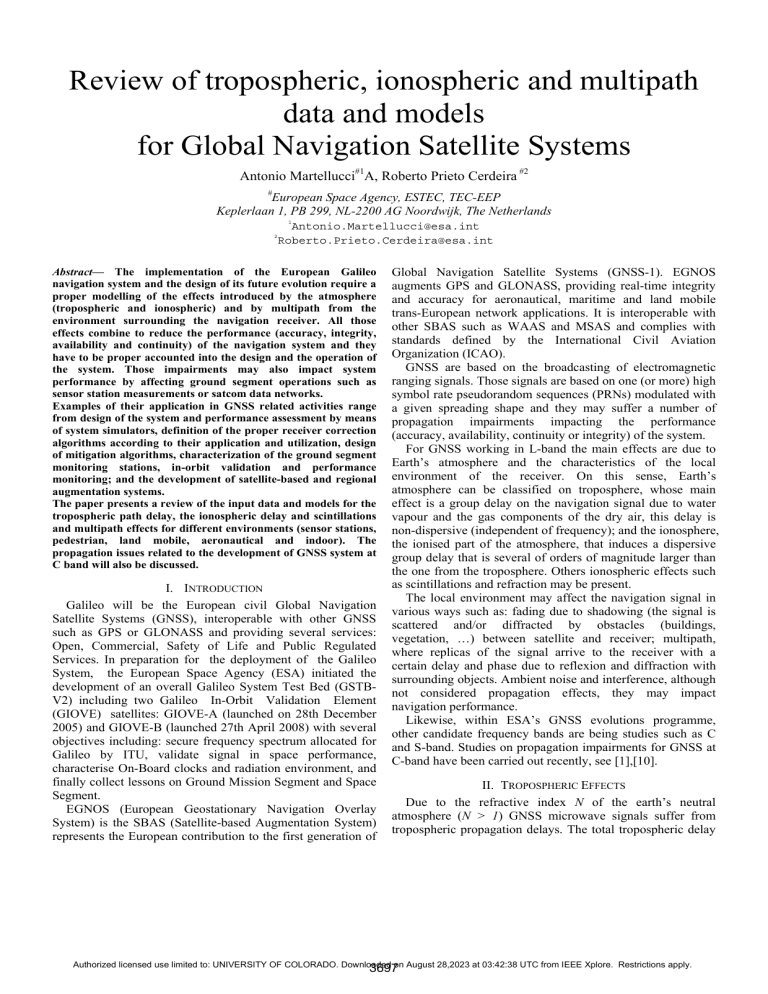
Review of tropospheric, ionospheric and multipath data and models for Global Navigation Satellite Systems Antonio Martellucci#1A, Roberto Prieto Cerdeira #2 # European Space Agency, ESTEC, TEC-EEP Keplerlaan 1, PB 299, NL-2200 AG Noordwijk, The Netherlands 1 Antonio.Martellucci@esa.int Roberto.Prieto.Cerdeira@esa.int 2 Abstract— The implementation of the European Galileo navigation system and the design of its future evolution require a proper modelling of the effects introduced by the atmosphere (tropospheric and ionospheric) and by multipath from the environment surrounding the navigation receiver. All those effects combine to reduce the performance (accuracy, integrity, availability and continuity) of the navigation system and they have to be proper accounted into the design and the operation of the system. Those impairments may also impact system performance by affecting ground segment operations such as sensor station measurements or satcom data networks. Examples of their application in GNSS related activities range from design of the system and performance assessment by means of system simulators, definition of the proper receiver correction algorithms according to their application and utilization, design of mitigation algorithms, characterization of the ground segment monitoring stations, in-orbit validation and performance monitoring; and the development of satellite-based and regional augmentation systems. The paper presents a review of the input data and models for the tropospheric path delay, the ionospheric delay and scintillations and multipath effects for different environments (sensor stations, pedestrian, land mobile, aeronautical and indoor). The propagation issues related to the development of GNSS system at C band will also be discussed. I. INTRODUCTION Galileo will be the European civil Global Navigation Satellite Systems (GNSS), interoperable with other GNSS such as GPS or GLONASS and providing several services: Open, Commercial, Safety of Life and Public Regulated Services. In preparation for the deployment of the Galileo System, the European Space Agency (ESA) initiated the development of an overall Galileo System Test Bed (GSTBV2) including two Galileo In-Orbit Validation Element (GIOVE) satellites: GIOVE-A (launched on 28th December 2005) and GIOVE-B (launched 27th April 2008) with several objectives including: secure frequency spectrum allocated for Galileo by ITU, validate signal in space performance, characterise On-Board clocks and radiation environment, and finally collect lessons on Ground Mission Segment and Space Segment. EGNOS (European Geostationary Navigation Overlay System) is the SBAS (Satellite-based Augmentation System) represents the European contribution to the first generation of Global Navigation Satellite Systems (GNSS-1). EGNOS augments GPS and GLONASS, providing real-time integrity and accuracy for aeronautical, maritime and land mobile trans-European network applications. It is interoperable with other SBAS such as WAAS and MSAS and complies with standards defined by the International Civil Aviation Organization (ICAO). GNSS are based on the broadcasting of electromagnetic ranging signals. Those signals are based on one (or more) high symbol rate pseudorandom sequences (PRNs) modulated with a given spreading shape and they may suffer a number of propagation impairments impacting the performance (accuracy, availability, continuity or integrity) of the system. For GNSS working in L-band the main effects are due to Earth’s atmosphere and the characteristics of the local environment of the receiver. On this sense, Earth’s atmosphere can be classified on troposphere, whose main effect is a group delay on the navigation signal due to water vapour and the gas components of the dry air, this delay is non-dispersive (independent of frequency); and the ionosphere, the ionised part of the atmosphere, that induces a dispersive group delay that is several of orders of magnitude larger than the one from the troposphere. Others ionospheric effects such as scintillations and refraction may be present. The local environment may affect the navigation signal in various ways such as: fading due to shadowing (the signal is scattered and/or diffracted by obstacles (buildings, vegetation, …) between satellite and receiver; multipath, where replicas of the signal arrive to the receiver with a certain delay and phase due to reflexion and diffraction with surrounding objects. Ambient noise and interference, although not considered propagation effects, they may impact navigation performance. Likewise, within ESA’s GNSS evolutions programme, other candidate frequency bands are being studies such as C and S-band. Studies on propagation impairments for GNSS at C-band have been carried out recently, see [1],[10]. II. TROPOSPHERIC EFFECTS Due to the refractive index N of the earth’s neutral atmosphere (N > 1) GNSS microwave signals suffer from tropospheric propagation delays. The total tropospheric delay 3697 Authorized licensed use limited to: UNIVERSITY OF COLORADO. Downloaded on August 28,2023 at 03:42:38 UTC from IEEE Xplore. Restrictions apply. in direction of a particular satellite - slant path delay (SPD) can be divided into a hydrostatic and a wet component. Using mapping functions, these two delays are projected into zenith direction and viceversa. SPD(ε ) = m h (ε ) ⋅ ZHD + m w (ε ) ⋅ ZWD (1) SPD(ε) = slant path delay [m] along elevation angle ε ZHD = zenith hydrostatic delay [m] ZWD = zenith wet delay [m] mh(ε) , mw(ε) = mapping functions of the hydrostatic and wet path delay along elevation angle ε For the the mapping functions, mh(ε) , mw(ε) , the model of Niell [1] is currently used. The ZHD and ZWD are related to the air refractivity N, which in turn is determined by values of air total pressure, P [hPa], temperature, T [K], and water vapour pressure, e [hPa]. e e N = K 1 ( P − e) + K 2 + K 3 2 ≡ T T (2) e e ⎞ −1 ⎛ −1 k 1 ( P − e) Z d + ⎜ K 2 + K 3 2 ⎟ Z v T T ⎠ ⎝ Zd and Zv are the compressibility factors of dry air and water vapour. Capital K is used for the formulation that does not include compressibility. In the following tables some experimental values of air refractivity coefficients available from different authors are given. The uncertainty of air refractivity parameters, with particular regard to K3, produces an rms fluctuation of the ZTD of about 6 mm on a global scale. TABLE I COEFFICIENTS OF THE NON-DOSPERSIVE AIR REFFACTIVTY Author(s) Smith& Wintraub [2] Thayer [3] Hasegawa and Strokesb. [4] Liebe [5] Bevis weighted [6] Bevisunweighted [6] Rueger best avail. [7] Rueger best aver [7] K1 1/hPa 77.607 ± 0.013 77.64 ± 0.014 77.6 ± 0.032 77.676 ± 0.023 77.6 K2 K/hPa 71.6 ± 8.5 64.79 ± 0.08 69.4 ±0.146 71.631 K3*10-5 K2/hPa 3.747 ± 0.013 3.776 ± 0.004 3.701 ± 0.003 3.74656 69.4 3.701 77.6 ± 0.05 77.695 ± 0.013 77.689 ± 0.0094 70.4 ±2.2 71.97 ± 10.5 71.295 ± 1.3 3.739 ± 0.012 3.75406 ± 0.03 3.75463 ± 0.0076 ∞⎛ e ⎞ e ZWD = 10 − 3 ⋅ ∫ ⎜ K 2′ + K 3 2 ⎟dh (4) h0 T T ⎠ ⎝ M K 2′ = K 2 − K1 w = 22.1 [K/hPa] Md Md = 28.9644 ; Mw = 18.0152 are the Molar weights of dry and wet air [g/mol] The zenith wet delay can also be estimated, with a reduced accuracy, from the vapour pressure at the height of the receiver, e0, and the local climatological parameters, λ and Tm related to the vertical profiles of air total pressure, temperature and water vapour pressure. R ⎛ K ⎞ e ZWD (e0 , λ , TM ) = 10 −6 ⋅ d ⋅ ⎜⎜ K 2′ + 3 ⎟⎟ ⋅ 0 ≈ TM ⎠ λ + 1 gm ⎝ (5) Rd K 3 e0 −6 ≈ 10 ⋅ g m TM λ + 1 This equation is assumed to be valid under the following λ +1 condition: e = e 0 ( p p 0 ) Rd = 287.054 [J/(Kg K)] ∞ ∞ e e Tm = ∫ dh ∫ 2 dh = Effective Mean temperature of the T T h0 h0 water vapor column above the receiver [K] g m = g (ϕ , h0 ) = 9.784 ⋅ (1 − 0.00266 ⋅ cos(2 ⋅ ϕ ) − 0.00028 ⋅ h0 ) = Gravity acceleration at the mass center of air [m/s2] In the framework of the Galileo project ESA used the European Centre for Medium-Range Weather Forecasts (ECMWF) reanalysis product ERA15 covering the period from 1979 to 1993 to derive the input parameters and the coefficients for the calculation of ZHD ZWD. ERA15 global fields are characterized by a horizontal resolution of 1.5 x 1.5 deg, a vertical resolution of 31 levels and a temporal resolution of 6 hours (00, 06, 12, 18 UTC),. The 31 levels are defined in terms of pressure (hPa), with a higher resolution in the planetary boundary layer, where the levels follow the earth surface. Values of temperature (K) and specific humidity (kg/kg), associated with these pressure levels, are also provided with the dataset. The analysis produced among the others, monthly statistics (unconditioned and conditioned to the hour of the day) of “surface data”, P, e, Tm, λ, with a world-wide coverage. Air total pressure, P, is assumed to be affected by a seasonal variation: The zenith hydrostatic delay ZHD can be modelled using total pressure at the antenna site. The model of Saastamoinen (see [6]) is a rather accurate hydrostatic model: 0.0022767 ⋅ p (3) ZHD = 1 − 0.00266 ⋅ cos 2ϕ − 0.00028 ⋅ h ϕ: Ellipsoidal latitude h: Surface height above the ellipsoid in [km] p: Total Surface pressure in [hPa] Therefore the ZWD is given by the following integral along the atmospheric profile: ( ) D y − a 3i ⎤ ⎡ X i D y = a1i − a 2 i cos ⎢2π ⎥ 365.25 ⎦ ⎣ a1i = average value of the parameter a2i = seasonal fluctuation of the parameter a3i = day of the minimum value of the parameter Dy.= day of the year [1 ..365.25] ( ) (6) In addition Tm, e and λ are assumed to be affected by both seasonal and diurnal fluctuations: 3698 Authorized licensed use limited to: UNIVERSITY OF COLORADO. Downloaded on August 28,2023 at 03:42:38 UTC from IEEE Xplore. Restrictions apply. ( ) ( ( )) D y − a3 i ⎤ ⎡ X i D y , H d = a1i − a 2 i cos ⎢2π ⎥ 365.25 ⎦ ⎣ (7) H d − b3 i D y ⎤ ⎡ −b 2 i D y cos ⎢2π ⎥ 24 ⎣ ⎦ Hd= hour of the day [0..24) b2i = amplitude of daily fluctuation. b3i,= hour of the day at which the minimum value occur. The model has been validated using and independent ECMWF global product covering the period from March to October 2002 with a spatial resolution of 1 x 1 deg. The global map of the model rms error is given in Figure 1. The overall rms errors of ZTD, ZHD and ZWD are 4.5, 1.6 and 4.4 cm with biases of 9, 0.6 and 8 mm, respectively. Those errors can be reduced by using as input actual meteorological ground measurements and as an additional step actual values of λ. ( ) ( ) error is dispersive, it can be estimated and eliminated by GNSS receivers working at two or more frequencies. The group delay experienced by an electromagnetic wave propagating through the ionosphere, σiono, is directly proportional to the Total Electron Content (TEC), neglecting higher order terms which usually account for less than 0.1 % of the delay), as follows: 40.3 40.3 (9) σ iono = ⋅ N ⋅ dl = ⋅ sTEC f 2 ∫ path f 2 where σiono is the group delay error [m], f is frequency [Hz], N is electron density [electrons.m-3], sTEC is slant Total Electron Content [electrons.m-2], and path is the propagation path between receiver and satellite. The sTEC may also be expressed in TECU (TEC units), where 1 TECU = 1016 electrons.m-2. At the L1 frequency (1575.42 MHz), the delay is approximately 16 cm for 1 TECU. The value of TEC depends on different factors such as time of the day, location, season, solar activity (which is related to the epoch within the solar cycle) or level of disturbance of the ionosphere, such as those due to geomagnetic storms. An example of VTEC map is shown in figure 2. Fig. 1 Map of the rms error of the tropospheric model in blind mode The input parameters of the model can be scaled from surface to height h by assuming: Tm (h) = Tms − α m ⋅ (h − hs ) (8) am= lapse rate of the mean temperature of water vapour, [K/km], also derived from ERA15. As an example the error of the model at 5000 m, in the upper part of the troposphere, the model error rms reduces to 2.5, 2.2 and 1 cm for ZTD, ZHD and the ZWD. III. IONOSPHERIC EFFECTS The ionosphere is a region of the Earth’s atmosphere ionised by solar radiation and lying between about 50 kilometres up to several thousand kilometres from Earth’s surface. The ionosphere affects radio wave propagation in different ways such as refraction, absorption, Faraday rotation, group delay, time dispersion or scintillations, and those effects are dispersive. For GNSS, working in L band, one of the most important ionospheric effect is the pseudo-range error introduced by the group delay on navigation signals (which is identical but with opposite sign to the carrier phase advance). This delay, if not corrected, can induce ranging errors up to several tens of meters in L band for days with high levels of electron density and low elevation satellites. As the ionospheric group delay Fig. 2 VTEC map in a grid of 5x5 degrees derived with NeQuick. EGNOS and other SBAS systems use a thin-shell approximation of the ionosphere and broadcast VTEC values for predefined grid points. A receiver, in order to correct ionospheric delay, first estimates the VTEC at the pierce-point (intersection between line-of-sight link from GPS satellite to user terminal and the thin shell layer) by interpolation from the surrounding grid points, and then applies a vertical-toslant mapping that depends on zenith angle at the pierce point. Galileo single frequency receivers will implement an algorithm for single frequency ionospheric corrections based NeQuick electron density climatological model and broadcast parameters estimated using dual-frequency TEC measurements from a network of Ground Sensor Stations. The algorithm estimates an Effective Ionisation Level (Az) for each sensor station, applicable for a period of typically 24 hours. In order to cope with potential mismodellings depending on location with respect to the magnetic field, the Az parameter is fitted to a second order polynomial function of the Modified Dip Latitude (MODIP): 3699 Authorized licensed use limited to: UNIVERSITY OF COLORADO. Downloaded on August 28,2023 at 03:42:38 UTC from IEEE Xplore. Restrictions apply. Error! Objects cannot be created from editing field codes.( 10) where µ is MODIP (in degrees) and a0, a1, a2 are the Az coefficients which are broadcast in Galileo Signal in Space [11]. The Az is used in Galileo receivers as input parameter for the NeQuick ionospheric model. The performance of the algorithm has been analysed in several publications using IGS data [12] and also data from GIOVE ground sensor stations [13],[14]. Multi-frequency receivers can eliminate first order ionospheric delay by combination of two or more frequencies. For the accurate representation of instantaneous ionospheric TEC, when dual frequency observables from several stations are available, more accurate results are found using a two layer model, such as the one proposed with the WARTK technique [15]. Other effect related to TEC appears in receiver that uses carrier smoothing filtering. Carrier smoothing is used in GPS receivers to reduce the effects of multipath and thermal noise. The noisy code measurements are used to estimate the bias on more precise but ambiguous carrier measurements by means of averaging with a Hatch filter. However, the code-carrier divergence, i.e. the effect on which the code is delayed proportionally to the TEC and the carrier is advanced by nearly the same amount, limits the use of the smoothing method by introducing a bias when large temporal ionospheric gradients are encountered. In solar maximum conditions, rates of change above 8 mm/s may occur in Europe with a probability of 0.001 for a quiet day, and 0.01 for a day with large geomagnetic storm [16]. For a 100-seconds smoothing, 8 mm/s is equivalent to a filter bias of -1.6 meters. Ionospheric scintillation is the other main propagation effect from the ionosphere on navigation signals. Ionospheric scintillations are rapid fluctuations of amplitude and phase of the radiowave signal caused by small-scale irregularities which modify the ionospheric refractive index. The development of Global Navigation Satellite Systems with safety of life services, such as Galileo, has shown that radionavigation signal propagation impairments due to ionospheric scintillations are a key driver of the system performance. Current analysis are based on ionospheric models and data for nominal averaged situations, however, extreme cases which happen more often during solar maximum years have not been understood completely and therefore the effects on GNSS under those situations is not fully characterised. The most commonly used parameter to characterise intensity fluctuations is the amplitude scintillation index S4, defined by equation: 12 ⎛ I2 − I 2 ⎞ ⎟ (11) S4 = ⎜ 2 ⎜ I ⎟ ⎝ ⎠ Likewise, phase scintillations are characterised by the standard deviation of the phase variations σφ. Strong scintillations can induce cycle slips and loss-of-lock in GNSS receivers on one or more signals simultaneously. Scintillations depend on location, time-of-day and solar activity. During nominal conditions, strong levels of scintillation are rarely observed in mid-latitudes, but they may be encountered daily during post-sunset hours in low latitude regions. Also in polar and auroral regions, non-negligible levels of phase scintillations have been observed. Ionospheric modelling is a challenging domain, depending on solar activity and its interactions with geomagnetic field; the ionosphere may deviate from its nominal behaviour. This happens, for instance, during severe geomagnetic storms. In those cases, it is essential for a safety of life system to confirm that the integrity of the computed corrections is still maintained while minimising the impact on availability and continuity of service. For this reason, accurate models or realistic synthetic/measured data of a disturbed ionosphere are needed for a complete qualification. The GISM model [17] is the model used as baseline for the analysis of ionospheric scintillations in the different Galileo segments. GISM is based on physical principles and statistical analysis of ionospheric characteristics (phase and amplitude PSD and PDF) and driven by an electron density climatological model (NeQuick) behind. Figure 3 shows a map of vertical S4 derived with GISM. A simple engineering model for the analysis of amplitude scintillation based on GISM outputs is presented in [18]. Fig. 3 Map of vertical S4 derived with GISM model IV. MULTIPATH EFFECTS Different propagation mechanisms (diffraction, reflection and scattering) are combined together originating signal variations that affect receiver performance. Shadowing and blockage due to obstacles, frequency selective fading due to multipath or large building penetration losses are some examples of the impairments which GNSS receivers may encounter due to the local environment. In a GNSS receiver, after antenna, RF and A/D conversion, the signal processing module, performs the autocorrelation of the incoming signal with locally generated replicas of the PRN codes in order to estimate the transit time of the signal from the satellite and thus the pseudorange. In the presence of multipath, the autocorrelation function is distorted, shifting the zero-crossing of the discriminator function and thus creating an error on the pseudorange estimation. Multipath is characterised by: amplitude, phase, time delay and phase rate of change. The phase rate of change is also referred to as Doppler fading bandwidth and represents the 3700 Authorized licensed use limited to: UNIVERSITY OF COLORADO. Downloaded on August 28,2023 at 03:42:38 UTC from IEEE Xplore. Restrictions apply. relative Doppler frequency change between the direct and multipath signal. For the analysis of multipath in static receivers, the multipath code phase error envelope has been extensively used in literature. This error envelope indicates the error bounds of a single specular multipath ray at any delay from the direct signal. It is often presented for a maximum delay of 1.5 the chip period assuming that longer delays do not affect the pseudorange estimation (true for negligible sidelobes in the autocorrelation function). For instance, Figure 4 plots the code phase multipath error envelope for some of the Galileo signals for a Signal to Multipath Ratio (SMR) of 6dB, bandwidth of 15 MHz, and different discriminator spacings. One of the current challenges for the analysis of multipath is to derive a clear methodology to implement realistic and reliable multipath models into any hardware and software simulation environment, and that allows assessing multipath performance in an unambiguous manner. A preliminary method and results into this work is given in [21]. An example of tracking error of BOC(1,1) signal for a given urban vehicular simulation is shown in Figure 5. Fig. 5 BOC(1,1) tracking for a simulation in urban environment. Fig. 4 Code phase multipath error envelope for different signals and discriminator spacings. The analysis of single specular multipath gives a good qualitative tool to understand different effects on the receiver. However, this kind of multipath is not representative of most environments and thus, complex channel models including a large number of reflectors should be used. In several cases, signal design with respect to multipath performance is performed using the error envelope, which may lead to misleading conclusions depending on the environment and type of application. For the Galileo Land Mobile case, a wideband channel model based on [19] can be used. It is based on a Tap Delay Line and it can be used in urban and rural (pedestrian and vehicle) and fixed environments. The output of the model is a complex fading time-series for each tap. The model is simple enough to be adapted into hardware signal simulators for receiver testing but it has several limitations such as a nonrealistic reduced number of taps to represent the delay spreaded energy and a lack of elevation dependency. A more versatile model is the proposed in [20] for Land mobile users. The model includes deterministic and stochastic representation of the multipath and the environment and it is able to generate a time-varying direct signal and a large number of reflections (in the order of 50) with varying delay, phase and amplitude. The model takes into account satellite elevation and azimuth, and changes in velocity of the vehicle during the simulation. The major limitation of this model is that the large number of output parameters is difficult to adapt into hardware or software simulations. V. CONCLUSIONS It is important to understand the origin and impact of the propagation effects discussed in this paper, and also to develop reliable models and design adequate mitigation techniques in order to achieve the required performance. There are some effective impairment mitigation techniques for some of them but in other cases they represent a challenge, in particular for applications that require not only high accuracy but also integrity of the signal, such as safety-of-life applications. REFERENCES [1] [2] [3] [4] [5] [6] [7] [8] 3701 NIELL, A.E. “Global mapping functions for the atmosphere delay at radio wavelengths”, Journal of Geophysical Research, Volume 101, No B2, pp. 3227-3246, 1996 E. K. Smith and S. Weintraub, “The Constants in the Equation for Atmospheric Refractive Index at Radio Frequencies”, Proceedings of the institute of Radio Science, 41, pp. 1035-1037, 1953 G. D. Thayer, “An improved equation for the radio refractive index”, Radio Science, vol. 9, n. 10, pp. 803-807, October 1974 S. Hasegawa & D. P. Strokesburry, “Automatic digital microwave hygrometer”, Review of Science Instruments, vol. 46, n. 7, July 1975. H. J. Liebe, Models of the Refractive Index of the Neutral Atmosphere at Frequencies Below 1000GHz, Chapter II.3.1.2, in The Upper Atmosphere-Data Analysis and Interpretation, edited by DiemingerHartmann-Leitinger,pp. 270-287, 1996 M. Bevis and al., “GPS Meteorology: Mapping Zenith Delay onto Precipitable Water”, American Meteorological Society, vol. 33, pp 379-386, 1994. J. M. Rüger,”Refractive Index Formulae for Radio Waves”, Proceedings, FIG XXII International Congress, Washington DC, 19-26 April 2002.(www.fig.net/pub/fig_2002/Js28/JS28_rueger.pdf) Krueger E., Schueler T., Guenter W., Martellucci A. and Blarzino G. “Galileo Tropospheric Correction Approaches developed within GSTB-V1”, ENC-GNSS 04, 16-19 May 2004, Rotterdam, The Netherlands. Authorized licensed use limited to: UNIVERSITY OF COLORADO. Downloaded on August 28,2023 at 03:42:38 UTC from IEEE Xplore. Restrictions apply. [9] [10] [11] [12] [13] [14] [15] [16] [17] [18] [19] [20] [21] Teschl, F., Schoenhuber, M., Perez-Fontan, F., Valtr, P., Hovinen, V., Kyröläinen, J., Prieto-Cerdeira, R., “Channel Characterization Studies at GNSS C-Band Frequencies”, in 4th ESA Workshop on Satellite Navigation User Equipment Technologies, Navitec 2008, Noordwijk, The Netherlands, December 2008. Béniguel, Y., Adam, J.-P., Jakowski, N., Hoque, M., Cueto, M., Radicella, S., Nava, B., Lannelongue, S., Prieto-Cerdeira, R., “Ionospheric Propagation Impairments for GNSS at C Band” in 4th ESA Workshop on Satellite Navigation User Equipment Technologies, Navitec 2008, Noordwijk, The Netherlands, December 2008. European Space Agency / European GNSS Supervisory Authority: “Galileo Open Service Signal In Space Interface Control Document (OS SIS ICD) Draft 1”, GAL OS SIS ICD/D.1, Iss.Draft, Rev.1, February 2008. Orus, R.; Arbesser-Rastburg, B.; Prieto-Cerdeira, R.; HernandezPajares, M.; Juan, J.M.; Sanz, J.; “Performance of Different Ionospheric Models for Single Frequency Navigation Receivers”, Beacon Satellite Symposium 2007, Boston, June 2007. Orus, R.; Prieto-Cerdeira, R., “GIOVE-A Experimentation Campaign: Ionospheric Related Data Analysis”, in 4th ESA Workshop on Satellite Navigation User Equipment Technologies, Navitec 2008, Noordwijk, The Netherlands, December 2008. Tossaint, M., Binda, S., Hahn, J., Falcone, M., Prieto-Cerdeira, R., Giuntini, F., “Galileo Initial Validation Step: GIOVE Navigation Message”, in ENC-GNSS08, Toulouse, France, April 2008. Hernandez-Pajares, M., Juan, J.M. and Sanz, J., “New approaches in global Ionospheric determination using ground GPS data”. Journal of Atmospheric and Solar Terrestrial Physics, Vol 61, pp 1237-1247, 1999. Prieto-Cerdeira, R., Arbesser-Rastburg, B., Orus, R. et al “Ionospheric modelling and validation for Satellite Based Augmentation Systems: the European EGNOS System example”, in 1st Colloquium Scientific and Fundamental Aspects of the Galileo Programme, Toulouse, France, October 2007. Beniguel, Y., “Global Ionospheric Propagation Model (GIM): a propagation model for scintillations of transmitted signals”, Radio Sci., May/June 2002. Thompson, P., Prieto-Cerdeira, R., “Consideration of Ionospheric Scintillation in the Design of C-Band VSAT Systems”, in Radiowave Propagation Models, Tools and Data for Space Systems Workshop, Noordwijk, The Netherlands, December 2008. Perez-Fontan, F.P., Vazquez-Castro, M., Cabado, C.E., Garcia, J.P. and Kubista, E., “Statistical modeling of the LMS channel”, IEEE Transactions on Vehicular Technology, 2001. Lehner, A., Steingass, A., “A Novel Channel Model for land mobile satellite navigation” in Proceedings of the 18th International Technical Meeting of the Institute of Navigation Satellite Division (ION GNSS 2005), Long Beach, California, USA, 2005. Schubert, F., Prieto-Cerdeira, R., Steingass, A., “GNSS Software Simulation System for Realistic High-Multipath Environments”, in 4th ESA Workshop on Satellite Navigation User Equipment Technologies, Navitec 2008, Noordwijk, The Netherlands, December 2008. 3702 Authorized licensed use limited to: UNIVERSITY OF COLORADO. Downloaded on August 28,2023 at 03:42:38 UTC from IEEE Xplore. Restrictions apply.
